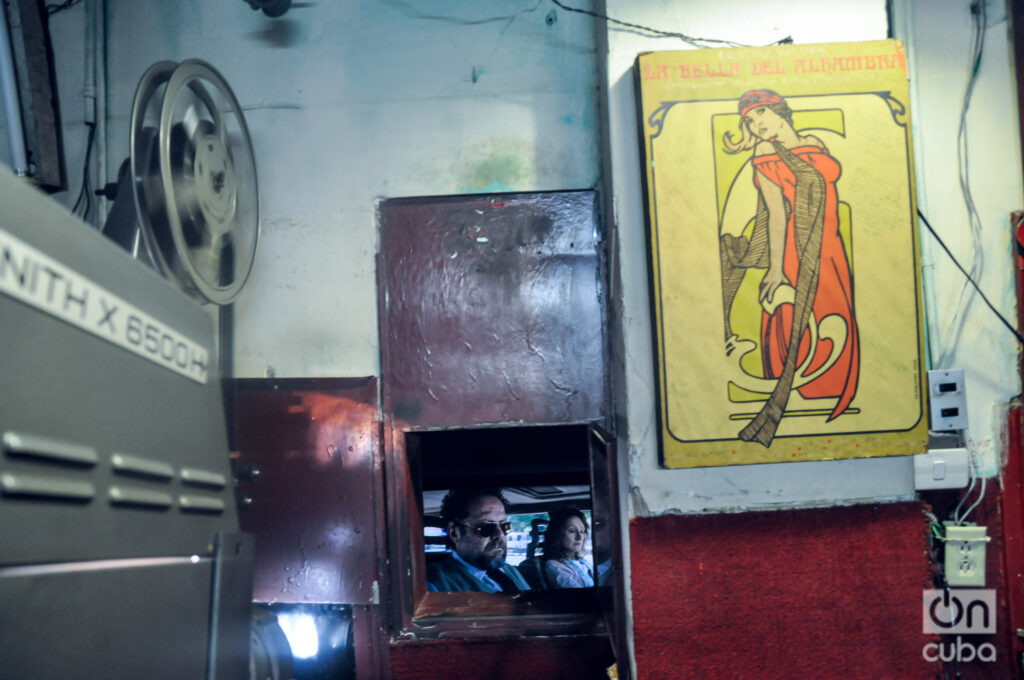During these days of the Havana International Film Festival, I am dusting off my archives. I am moved to remember those dark rooms where everything began with the unmistakable beats of the musical curtain composed by José María Vitier.
I used to be one of those people called “festival-goers.” I spent the day, from morning to night, walking quickly down 23rd Avenue from one theater to another. I immersed myself in the inevitable lines to get into each showing, and in the middle of the day I was content with having a 5-peso pizza accompanied by a 1-peso soda (a detail that makes it clear that this happened quite a while ago).


I walked around with the Festival Diary under my arm, marking on the guide the three or four films I would see the next day. The last showing was a challenge: tiredness often got the better of me and I ended up falling asleep in my seat. Even that had its charm: waking up with the final credits was part of the ritual.

I think I was trapped by Havana because I saw it in December, dressed for the movies. I arrived for the first time from Holguín, with a group of friends. There were about eight of us, young and enthusiastic, carrying a small camera with only one roll of film for the whole stay. Every photo from that trip is a group photo, and behind us there is always a line of people waiting to enter a movie theater.

That first visit was more than twenty years ago; I wasn’t even a photographer yet. From then on, every December I had a date in Havana. I stayed at my aunts’ house and stayed there for the first two weeks of the month, while the Festival lasted. When I returned to Holguín, I bragged at school about the movies I had seen and the famous people I had met. Sometimes I exaggerated a little. There were no social media or smartphones to contradict me; nor to leave testimony of my stories. Words and a bit of youthful charisma were enough to be credible.

On one of those festival dates I discovered Fernando Birri, an Argentine filmmaker and a reference in Latin American cinema. I happened to walk into a retrospective at the La Rampa movie theater and came across Un señor muy viejo con unas alas grandes, his adaptation of the story by Gabriel García Márquez. The film, a Cuban-Argentine co-production, had a luxury cast that included Daisy Granados and Adolfo Llauradó. But what struck me most was Birri in the role of the fallen angel, with his white beard and unmistakable smile. The image of the protagonist soaring through the skies stayed with me.

Days later, I saw him in person on 23rd Avenue. It was impossible not to recognize him. I followed him with my eyes as he disappeared among the people, as if at any moment he could take flight towards the fictional world he had created in his film. I have no photos of that sequence; back then I didn’t carry a camera everywhere like I do now. But it doesn’t matter, that surreal scene remained imprinted on my retina.


Years later, at another festival, I saw Gabriel García Márquez, the inspiration for Birri’s film. There he was, sitting in the Karl Marx Theater with his wife, Mercedes, and a group of Cuban friends like Alfredo Guevara and Julio García Espinosa. I don’t remember what film we were about to see, but I didn’t miss the opportunity to photograph them. The image was funny: Gabo and Alfredo seem to be gossiping about what Mercedes was watching on her phone.

At a Havana Film Festival all kinds of stories can come together. One of the most unusual things that happened to me was getting lost in the Yara movie theater (who gets lost in a theater?). When I opened the wrong door, I found myself in the projection booth. There was the projectionist, the anonymous magician who manipulated a roll of film in the now classic 35-millimeter format, a relic in the digital age. A few meters away, the machine was screening, transforming a beam of light into movement at thousandths of a second intervals. Each frame came to life thanks to a lens that inverted and focused the images on the screen; that magic. From that privileged place, the heart of the cinema, I saw a film like never before: through a small window.


Random scenes like these cross my memory during this time of the Festival. Now, when I look through a bunch of photos taken in a hurry, each one holds a fragment of the past, a story to be told. They are images that capture encounters, glances and the constant movement of December in Havana, when cinema becomes the protagonist of the city.

Nostalgia for those days makes me think that the Film Festival not only projects stories on screens; it also creates them in the lives of those who live it intensely. The films end, but the memory of what happens around them remains. The true light of the dark room.










